

Framework to Manage Change in Your Marketing Organization. 5 Ways Nonprofits Are Growing Change Muscle Today. Like many organizations, nonprofits struggle with how to support their people through new ways of working.

They also experience unique roadblocks, such as issues with donor engagement and volunteer burnout. Managing change for them can be tricky, especially since the disruptive force of the pandemic is hitting smaller nonprofits particularly hard. Nonprofits and Change Management Here are five ways nonprofits are growing their change muscle today: 1. The transition to virtual services during the pandemic created anxiety for many nonprofits, including Austin-based Broadcast Your Love (BYL). Prosci’s ADKAR Model helped address the barrier points BYL leaders and instructors faced as they looked at ways the organization could adjust to change. Source: Broadcast Your Love 2. Most nonprofits bend over backwards to get funding.
Counseling centers have seen telehealth as an opportunity. 3. High turnover among executive leaders at nonprofits is common. 4. 5. Source: Heart House. How the pandemic transformed digital manufacturing. In 2020, industrial digitization faced its biggest test to date.
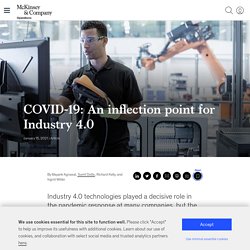
Confronted with the largest health and economic crisis in recent history, companies across sectors were forced into extraordinary measures to protect their people and maintain operations. While some contended with keeping the operations running in the face of shortages of workers or raw materials, others struggled to keep up with the sudden spike in demand. Did the technologies of the ongoing Fourth Industrial Revolution (or Industry 4.0) help those companies in their efforts?
Analysis of a new McKinsey survey’s results suggests three outcomes: a win for companies that had already scaled digital technologies, a reality check for those that were still scaling, and a wake-up call for those that hadn’t started on their Industry 4.0 journeys. A State Government's Rapid Pivot to More Successful Change. At Prosci, we talk about the need to pivot around purpose during a crisis and to anchor to collective purpose as an organization.
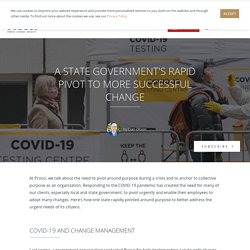
Responding to the COVID-19 pandemic has created the need for many of our clients, especially local and state government, to pivot urgently and enable their employees to adopt many changes. Here’s how one state rapidly pivoted around purpose to better address the urgent needs of its citizens. Last spring, a government organization contacted Prosci for help implementing a state-wide change management strategy as part of their COVID-19 response. Change management had been on their radar, but the pandemic made it clear that they needed to help employees adopt and use changes effectively if they were going be successful serving their citizens.
Pivoting Around Purpose The client faced a number of urgent issues common to state governments across the U.S., including: Public sector: how to create a culture of change. Private sector organisations that began digital transformation before the coronavirus pandemic suffocated business as usual were equipped and agile enough to revamp their strategies and operations, and thrive despite the chaos.
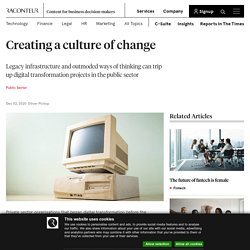
And laggards quickly realised that to keep pace they needed to invest in digital technologies and accelerate digital transformation plans. Meanwhile, those operating in the public sector, lumbered with legacy systems unsuitable for the digital age, looked on with envy, twiddling their thumbs. A slight exaggeration, perhaps, but it is a truism that the public sector is notoriously slow to embrace technology. There is a pervading sense, though, that COVID has necessitated a levelling-up across the sector. 6 future retail trends for 2021, 2025 and 2030.
The coronavirus pandemic has accelerated future retail trends as many businesses rapidly adopt new services and technologies.

Small businesses have been forced to develop digital platforms, in-store payments have moved away from cash and orders delivered by drones no longer seem worlds away. So what will shopping look like in 2021, 2025 and 2030? By 2021 1. Return of physical stores. Transformation + Emergence in Public Sector Innovation. This collection of terms is used fairly regularly when talking about innovation — in the public sector, and elsewhere.
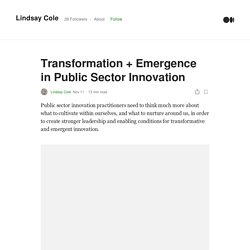
Each has a different meaning, with a different ambition, that can provide an interesting and useful view into what it is that an innovation effort might be trying to do, and how it might work toward that ambition. This section draws on work from Benyamin Lichtenstein, as well as from some of the frameworks shared later in the article. But first, an important note about levels and scale. Healthcare innovation: Building on gains made through the crisis. Medicine is a living science that prides itself on continual discovery.
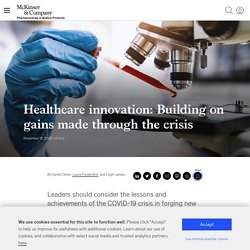
In recent years, healthcare innovators have brought us artificial-intelligence algorithms that arguably read chest X-rays as well as or better than radiologists, inexpensive genomic sequencing that can guide personalized cancer treatments, and vast improvements in population health management through big data and analytics, to name just a few examples. While the COVID-19 pandemic has placed unparalleled demands on modern healthcare systems, the industry’s response has vividly demonstrated its resilience and ability to bring innovations to market quickly. But the crisis is likely far from over and the sector’s innovation capabilities must continue to rise to the challenges presented both by COVID-19 and the economic fallout from its spread.
While many industries are facing unprecedented disruption, medicine and healthcare are uniquely affected given the nature of this crisis. A grown-up understanding of evidence. In government, there’s a frequent disconnect between policy intent and what people experience on the ground.
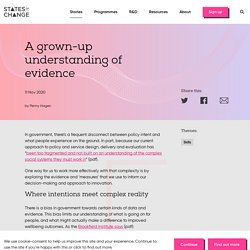
In part, because our current approach to policy and service design, delivery and evaluation has “been too fragmented and not built on an understanding of the complex social systems they must work in” (pdf). One way for us to work more effectively with that complexity is by exploring the evidence and ‘measures’ that we use to inform our decision-making and approach to innovation. Where intentions meet complex reality There is a bias in government towards certain kinds of data and evidence. This bias limits our understanding of what is going on for people, and what might actually make a difference to improved wellbeing outcomes.
New Operating Models: An emerging practice for the future of local government. These local government innovators are all experimenting with different ways to address complex challenges, by moving attention and resources upstream of service delivery to create the conditions that enable citizens to thrive.
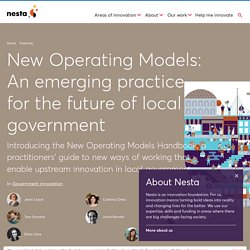
To do this they have adopted new ways of working – new operating models – that acknowledge the complexity and interconnectedness of social issues and the people and organisations that aim to tackle them. The work of these innovators, and the experiences of the communities they serve, has informed the development of a framework which characterises what new operating models in local government look like in practice. We describe this framework, the drivers behind it and the work that has informed it in Introducing New Operating Models. Exnovation: the timely shift for public sector transformation. Change Manager's Casebook: 300 case scenarios: different industries & countries (10 October 2020) by Peter Nixon. The Yin-Yang Military: Ambidextrous Perspectives on Change in Military Organizations (September 2020) by Jacqueline Heeren-Bogers, René Moelker, Esmeralda Kleinreesink, Jan Van der Meulen, Joseph Sothers and Robert Beeres (Editors)
Becoming the Change: Leadership Behavior Strategies for Continuous Improvement in Healthcare (1 September 2020) by John Toussaint and Kim Barnas. Innovating in insurance. Amazon's COVID-19 blog: daily updates on how we're responding to the crisis. Click here to jump to daily updates below Highlights 1.
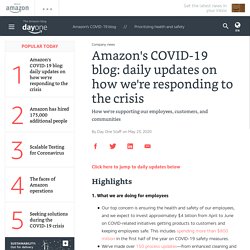
What we are doing for employees Our top concern is ensuring the health and safety of our employees, and we expect to invest approximately $4 billion from April to June on COVID-related initiatives getting products to customers and keeping employees safe. When Will It Be Safe To Fly Again? Editor's Note: This article was first published in Forbes. For Oliver Wyman's ongoing strategic advice and expertise on what healthcare industry stakeholders should do in response to the rapidly evolving novel coronavirus (COVID-19) pandemic, see our ongoing series.
After the terrorist attacks on September 11, 2001, it took the nation’s aviation industry about a decade to fully recover. There were two recessions in the following 10 years that didn’t help, but one of the persistent problems was that Americans were nervous about traveling, despite the low odds of being involved in a terrorist attack. The immediate impact on aviation from COVID-19 dwarfs the aftermath of 9/11, with a drop in demand in excess of 95 percent versus around 30 percent in the months following the attacks. Consumer-goods companies and operating models for the next normal. This article was written collaboratively by the McKinsey Consumer Goods and Organization Practices, groups that span all of our regions and include: Ayush Agnihotri, Bryan Logan, Kristi Weaver, Oren Eizenman, Kate Lloyd George, and Lauren Ratner. The COVID-19 pandemic is posing staggering health and humanitarian challenges. As the crisis evolves, companies must act on multiple fronts to protect their employees, customers, supply chains, and financial performance.
Retail and consumer-goods sectors have been particularly affected, with frontline employees directly at risk and companies struggling with demand that is either rapidly evaporating or surging well past the available supply. These most trying of circumstances have forced organizations to adapt quickly. In the process, many have achieved what they had aspired but failed to deliver for years. Looking to the Future of Air Travel. As the battle against the SARS-CoV-2 virus takes it toll on the global economy, no industry has been harder hit than aviation. In the United States, the major carriers have seen passenger numbers and revenue plummet. In 2019, the United States transportation security administration (TSA) screened around 2.5 million passengers every day across the U.S., with some variation according to the day of the week.
In April 2020, that dropped to between 90,000 and 130,000 passengers. Harvard Business Review sat down to discuss the challenges (and opportunities) facing the industry with Jon Ostrower, the editor-in-chief of The Air Current, Courtney Miller, managing director of analysis for The Air Current, and Dan McKone and Alan Lewis, two Boston-based managing directors at L.E.K. Consulting who have experience advising major airlines.
Apparel Retail Forever Changed: Moving Beyond COVID-19. Apparel Retail Forever Changed: Moving Beyond COVID-19. The Post-COVID-19 Flight Plan for Airlines. To predict the market structures that could arise given the different duration scenarios, we first take into account airlines’ starting positions in terms of liquidity and balance sheet strength. Then, to predict viability, we factor in potential government support as well as any given company’s ability to adjust the cash-out. Predicting which airlines that governments will choose to continue to support for more than a few weeks or months is complex. “Telehealth for all” could be the answer to healthcare reform.
The coronavirus is getting us comfortable with the virtual doctor’s appointment, and that’s going to ultimately change the entire conversation about the cost of healthcare. The U.S. healthcare system is expensive and difficult to “fix” for a lot of well-documented reasons, from the oddity of health insurance as a third-party intermediary to a business model that profits most when people are sick. But the problems all collapse into one core fact: There’s vastly more demand for healthcare than supply. So, naturally, prices surge.
Future factory: how does it look and who's working there? The future factory may not be as far away as you think. Governments must win public trust to deliver service innovation: BCG. 2019 health care industry leaders survey. Accelerating change is now a basic feature of the health care industry. Deloitte’s discussions with CEOs across the industry offer insights into drivers of change, priorities, and worries, and how the definition of success is evolving. Healthcare Trends: Coronavirus and Pandemic-Related Change. Expert says fashion weeks represent an industry unwilling to change. La gestion du changement en contextes et milieux organisationnels publics (2020) par Bachir Mazouz et Stéphanie Gagnon. Mining automation: is Mali leading us into the future of work? Numérique : la transformation des métiers du droit.
A l’ère de la transformation numérique et des évolutions technologiques, le métier de juriste se trouve plus que jamais confronté aux innovations. Top 5 Challenges Automotive Industry Will Face In The 2020s. Pourquoi la transformation digitale du luxe est un projet tourné vers l’humain ? L’expérience client, sujet central des stratégies de marque. Au coeur de la transformation numérique des minières.
Podcast with Kelly Okamura - a change agent in the fashion industry. Manufacturing 2020. Gartner's Predictions for Retailers Show More Change Ahead. The how of digital and analytics in insurance. November 15, 2019Insurance executives are acutely aware of the need to imbue their company with digital and analytics capabilities. The next horizon for industrial manufacturing: Adopting disruptive digital technologies in making and delivering. In the past few years, advanced industrial companies have made solid progress in improving productivity along the manufacturing value chain.
Catherine Pollard, the Under-Secretary-General for Management Strategy, Policy and Compliance, visited Fairleigh Dickinson University. Finance Change Management: Top-Down Or Bottom-Up? Disrupt Yourself, With a New Introduction: Master Relentless Change and Speed Up Your Learning Curve (2019) by Whitney Johnson. Innovation and Change in Non-Profit Organizations: Case Studies in Survival, Sustainability and Success (2019) by Don Macdonald (Editor)
Change Management And Other Lessons From An Energy Giant. Managing Change In The Non-Profit Space by Selena Wilson. Making Sense of Organizational Change and Innovation in Health Care: An Everyday Ethnography (2019) by Anne Reff Pedersen. Navigating from the Industrial Age to the Contextual Age. The Digital Paradox Of Change In The Oil And Gas Industry. The future of oil and gas is now: How companies can decarbonize. Cover Story: Banking’s digital revolution is here but no one is ready What is driving change in the events industry? What Putting Patients First Really Looks Like. Technology push innovation in government. Change Management in Nonprofit Organizations: Theory and Practice (2019) by Kunle Akingbola, Sean Edmund Rogers and Alina Baluch. Ocean plastic is just the beginning for the future of packaging. What AI can do for the insurance industry.
A 10 point guide to the lure and pitfalls of machinery of government changes. Fixing The Plastics Problem: A Blueprint For Change. Driving Change In Utilities – It’s Not Just A Pipe Dream. The coming trends of mobility transformation. L'assurance à l'ère du digital. What the Wine Industry Understands About Connecting with Consumers. Manufacturing transformation: why the sector must go digital. How digital lending is remaking credit, including digital mortgages. The Future of Manufacturing-Interactive guide. Reimagining the mobility ecosystem: A CEO’s guide. Are Healthcare Organizations Ready for Change? Fixing The Plastics Problem: A Blueprint For Change.
How to Adapt to Changes in Your Industry. Managing Healthcare Integration: Adapting Project Management to the Needs of Organizational Change - Aaron Gordon, Julien Pollack, 2018. 3 Steps for Engaging Health Care Providers in Organizational Change. Leading Change in Military Organizations: Primer for Senior Leaders (2018) by Dr Thomas P. Galvin. Creating a performance culture at Saudi Telecom. How Adidas Found Its Second Wind. The History Behind Adidas’s Success – In Pictures. Managing Change: A Model for Organisational Readiness to Adopt Pharmacy Information Systems.
Danaher’s Instruments of Change. DHA launches world's first comprehensive healthcare change management framework. A roadmap for a digital transformation. Leading and Managing Change in Schools. Future of Manufacturing 2018. Global Energy Perspective 2019. Global Energy Perspective: Accelerated Transition. UCM Séminaire 3.07.2018 - Le Changement dans les systèmes de santé à l'étranger.